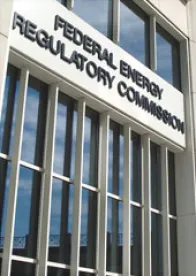On September 28, 2017, the Department of Energy (“DOE”) issued a Notice of Proposed Rulemaking (“NOPR”) proposing that Federal Energy Regulatory Commission (“FERC”) exercise its authority under sections 205 and 206 of the Federal Power Act (“FPA”) to direct regional grid operators to revise their wholesale electricity market rules to pay nuclear and coal-fired power plants for contributing to grid reliability.
Secretary of Energy Rick Perry proposed the rule for final action by FERC under section 403 of the Department of Energy Organization Act. The rule would add a new paragraph to section 35 of FERC’s regulations1 allowing full recovery of costs for certain eligible units. Eligibility is determined by, inter alia, the ability to provide energy and ancillary reliability services and the maintenance of a 90-day fuel supply on site. Eligible units must be located within the market areas of FERC-approved regional transmission organizations (“RTOs”) or independent system operators (“ISOs”) and cannot be subject to cost-of-service rate regulation by a state or local authority.
The proposed rule would direct ISOs and RTOs to file tariff amendments to set rates for energy purchases from eligible resources, that is, to provide cost-based rates for power plants that meet the set eligibility requirements. Recoverable costs would include operating and fuel expenses, costs of capital and debt, and a return on equity.
Among the stated bases for the rule is the high number of nuclear and coal-fired power plant retirements since 2002. Citing the August 2017 DOE “Staff Report to the Secretary on Electricity Markets and Reliability,”2 the DOE notes that units that had announced pending retirements had been used to meet demand during the 2014 Polar Vortex, demonstrating their necessity for grid resiliency. The DOE also cites in the NOPR an IHS Markit study asserting that wholesale electric price signals are inadequate to ensure long-term grid resilience.3
Because the final rule requires an exercise of FERC’s authority under sections 205 and 206 of the FPA, the DOE argues that neither an Environmental Assessment nor an Environmental Impact Statement is necessary for the NOPR.
The DOE has directed FERC to complete the final action on the rule within 60 days from the date of the publication of the NOPR in the Federal Register or, alternatively, to issue the proposed rule as an interim final rule, effective immediately, allowing for later modification after consideration of public comments.4 The DOE directs that the final rule take effect within 30 days of its publication in the Federal Register and that RTOs and ISOs submit compliance filings within 15 days of the effective date of the rule.
1 The new paragraph would be codified at 18 C.F.R. § 35.28(g)(10).
2 U.S. Department of Energy, Staff Report to the Secretary on Electricity Markets and Reliability, August 2017.
3 IHS Markit, “Ensuring Resilient and Efficient Electricity Generation: The Value of the current diverse US power supply portfolio.”
4 The NOPR has not yet been published in the Federal Register.





 />i
/>i

